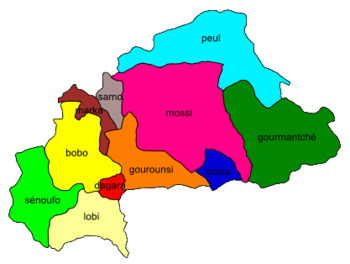Samo language (Burkina)
Samo (Sane, San, Sa) is a dialect cluster of Niger-Congo languages spoken in Burkina Faso. They are unclassified within Niger–Congo.[3] They are also called the Samuic languages by Güldemann (2018), who tentatively classifies them as part of the Gur languages.[3]
| Samo | |
|---|---|
| Sane | |
| Region | Burkina Faso |
Native speakers | (230,000 cited 1995–1999)[1] |
| Language codes | |
| ISO 639-3 | Variously:stj – Matya Samosym – Maya Samosbd – Southern Samo |
| Glottolog | mand1437[2] |
 Majority areas of Samo speakers, in grey, on a map of Burkina Faso | |
Varieties
Intelligibility between Samo varieties is low. The following have been coded as separate languages:[4]
- Matya Samo, spoken in Kossi Province, Sourou Province (Mouna and Solenzo areas)
- Maya Samo, spoken in Sourou Province, Yatenga Province, and Zondoma Province
- Southern Samo, spoken in Nayala Province (Nouna and Solenzo areas); Sourou Province; Sanguie Province; Passore Province[5]
Demographics
Samo dialect populations and locations:[6]
| Dialect | Region | Population (1985) | Population (2001[7]) |
|---|---|---|---|
| Maka | Southern, surrounding Toma | 61,883 | 84,996 |
| Matya | Northwest, to the west and north of Tougan (excluding Toéni area) | 33,675 | 46,252 |
| Matya | Far Northwest (Toéni region) | 9,942 | 13,655 |
| Maya | Northeast, surrounding Kiembara and Bangassogo | 38,393 | 52,732 |
| all | Total | 143,893 | 197,635 |
List of Samo villages organised by department and dialect:[6]
| Dialect | Province | Department | Villages |
|---|---|---|---|
| Maka | Mouhoun | Tchériba | Bissandérou, Orobié, Youbou |
| Maka | Nayala | Gassan | Dieré, Djimbara, Gassan, Labara, Laré, Moara, Téri |
| Maka | Nayala | Gossina | Bosson, Boun, Gossina, Kalabo, Koayo, Le Koun, Madamao, Massako, Naboro, Nianonkoré, Nypon, Sui, Tandou, Tarba, Zebassé |
| Maka | Nayala | Kougny | Goin, Gougnan, Gouri, Kamba, Kibiri, Kougny, Niaré, Nimina, Sébéré, Tiouma |
| Maka | Nayala | Toma | Goa, Goussi, Koin, Kola, Konti, Niemé, Nyon, Pankélé, Samba, Sawa, Sien, Siepa, To, Toma, Yayo, Zouma |
| Maka | Nayala | Yaba | Biba, Bo, Bounou, Kéra, Kisson, La, Loguin, Sapala, Saran, Siena, Tiema, Tosson, Yaba |
| Matya | Sourou | Di | Benkadi, Poura |
| Matya | Sourou | Kassoum | Bangassi, Bao, Bassam, Bonro, Diele, Doussoula, Fialla, Fian, Fianra, Kankani, Kassoum, Koularé, Kourani, Mara-Grand, Mara-Petit, Ourkoum, P’Nare, Peni, Sorona, Soumara Boumba, Soumarani, Tianra, Tiao, Tombila, Toungourou, Wawara |
| Matya | Sourou | Lanfiéra | Guiedougou, Lanfiéra |
| Matya | Sourou | Tougan | Da, Dimboro, Diouroum, Dissi, Gonou, Gosson, Kassan, Kawara, Kouy, Nassan, Tougan, Tourgare, Zinzin |
| Matya? | Sourou | Toéni | Dagale, Domoni, Dounkou, Gome, Gon, Gorguéré, Kware-Manguel, Kware-Toksel, Louta, Toéni |
| Maya | Sourou | Gomboro | Ganagoulo, Gomboro, Konga, Sia |
| Maya | Sourou | Kiembara | Bangassogo, Gan, Goueré, Gouyalle, Kiembara, Ouelle |
| Maya | Sourou | Lankoué | Lankoué Samo, Rassouli, Tourouba |
| Maya | Sourou | Toéni | Sanan, Sanga, Semé |
| Maya | Sourou | Tougan | Bonou, Bouare, Boussoum, Daka, Guimou, Niankore, Touare, Yéguéré |
Sample vocabulary
Sample basic vocabulary of Samo dialects:[6]
| Village | Dialect | eye | ear | nose | tooth | tongue | mouth | blood | bone | water | tree | eat |
|---|---|---|---|---|---|---|---|---|---|---|---|---|
| Toma | Maka | jǐ | to | ɲɛ̃ | sɔ | lɛwɔ | lɛ | mɑ̀ | wɛ | mú | dɑ | ɑ̀mɑ́mbíː |
| Kouy | Matya | jɛrːɛ | toro | jiːni | sɔ̃ːnɛ | nɛnɛ | lɛ | mɪjɑ̀ | jɛrɛ | mú | dɑ́ | ɑnebɑ́rè |
| Kassoum | Matya | ɲɑ́n | toro | ɲú | sɔ̃n | nɛnɛ | lɛ | mɪjɑ̀ | jɛr | mũ | dɑ́ | ɑ̀nèbɛrɛ |
| Toéni | Matya | jɛ | toro | jí | sɛ | nɛn | li | mɑ̌ː | wɑ | mũ | jidɑ̀ | mɑːbɛ̀rɛ̀ |
| Bounou | Maya | ɲoːnì; jɛrɛ | toro | ɲinijɛrɛ | so | leːnè | lɛ | mɑ̌ | jɑre | mu | dɑ | ɑfɑ́bjèrè |
| Kiembara | Maya | ɲɛ́nɛ̀nɛ̀ | tɔrɔ | ɲìní | so | lɛ́lɑ̀ːnɑ̀ | lɛ́ | mɑ̌ː | jɛ̀rɛ̀ | mṹ | dɑ́ | ɑ̀gɑ̀bɛ̀rɛ̀ |
| Bangassogo | Maya | jere | toro | jindì | so | lelene | le | ɲɑ̀mɑ | wɛrɛ | mú | jídɑ | ɑbɑ́brì |
| Lankoué | Maya | jɛrɛ | toro | sinde | sɔ̀ | lemìnì | lɛ | jõ̀mɑ | wɛrɛ | mú | jidɑ̀ | ɑbɑbɛ̀rɛ̀ |
Notes and references
- Matya Samo at Ethnologue (18th ed., 2015)
Maya Samo at Ethnologue (18th ed., 2015)
Southern Samo at Ethnologue (18th ed., 2015) - Hammarström, Harald; Forkel, Robert; Haspelmath, Martin, eds. (2017). "Mande Samo". Glottolog 3.0. Jena, Germany: Max Planck Institute for the Science of Human History.
- Güldemann, Tom (2018). "Historical linguistics and genealogical language classification in Africa". In Güldemann, Tom (ed.). The Languages and Linguistics of Africa. The World of Linguistics series. 11. Berlin: De Gruyter Mouton. pp. 58–444. doi:10.1515/9783110421668-002. ISBN 978-3-11-042606-9.
- "Burkina Faso". Ethnologue, 22nd edition. Retrieved 2019-09-25.
- The Seenku a.k.a. Sembla language is also called 'Southern Samo'.
- Berthelette, John (2002). Survey report on the San (Samo) language. SIL Electronic Survey Reports 2002-005. (PDF)
- Estimate, with 2.68% annual increase
gollark: Maybe JabbaScript (idea from my misspelling of Java).
gollark: JavaScriptJava!
gollark: JavaJava and ScriptScript.
gollark: Javascript.js
gollark: You should allow extra node creation.
This article is issued from Wikipedia. The text is licensed under Creative Commons - Attribution - Sharealike. Additional terms may apply for the media files.